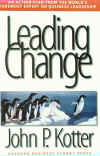John Kotter is the leadership and change guru at the Harvard Business School. He has written a number of seminal books – Leading Change published in 1996 sets out the 8 Step Process of Creating Major Change. This is summarised below along with the 8 errors common to failure in change programmes.
| Leading Change John Kotter | |
| Eight Step process of creating major change | 8 Errors Common to Organisational Change Efforts |
| Establishing a sense of urgency | Allowing too much complacency |
| Creating a guiding coalition | Failing to create a sufficiently powerful guiding coalition |
| Developing a vision and strategy | Underestimating the power of vision |
| Communicating the change vision | Undercommunicating the vision by a power of 10 |
| Empowering broad based action | Permitting obstacles to block the new vision |
| Generating short term wins | Failing to create short term wins |
| Consolidating gains and producing more change | Declaring victory too soon |
| Anchoring new approaches in the culture | Neglecting to anchor changes firmly in the corporate culture |
More details on the 8 Step process can be found here http://kotterinternational.com/KotterPrinciples/ChangeSteps.aspx
Kotter goes on in Leading Change to compare 20th and 21st century organisations with reference to their structure, systems and culture. This is set out in the table below.
| The Twentieth and Twenty-first century organisations compared | |
| Twentieth century | Twenty-first century |
| STRUCTURE | |
| Bureaucratic | Nonbureaucratic, with fewer rules and employees |
| Multi-levelled | Limited to fewer levels |
| Organised with the expectation that senior management will manage | Organised with the expectation that management will lead, lower level employees will manage |
| Characterised by policies and procedures that create many complicated internal dependencies | Characterised by policies and procedures that produce the minimal internal dependence needed to serve customers |
| SYSTEMS | |
| Depend on few performance information systems | Depend on many performance information systems, providing data on customers especially |
| Distribute performance data to executives only | Distribute performance data widely |
| Offer management training and support systems to senior people only | Offer management training and support systems to many people |
| CULTURE | |
| Inwardly focused | Externally orientated |
| Centralised | Empowering |
| Slow to make decisions | Quick to make decisions |
| Political | Open and candid |
| Risk averse | More risk tolerant |

Leave a comment